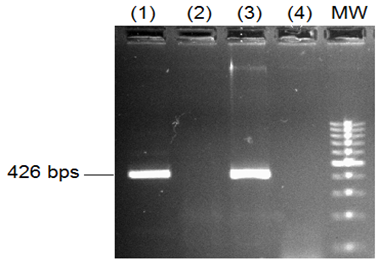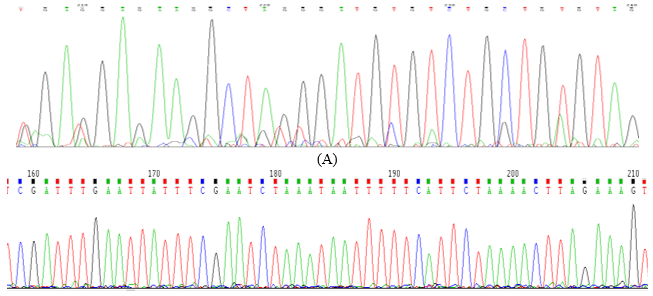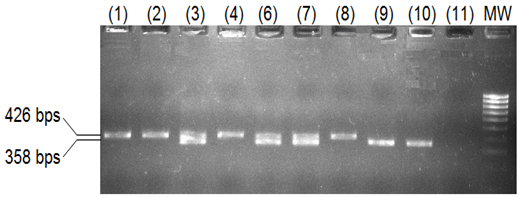Exploring the Multiplex PCR For Detection Of Animal-Derived Ingredients In Vegetarian Foods
Thuan Duc Lao, Thuy Ai Huyen Le*
|
|
Department of Pharmaceutical and Medical Biotechnology, Faculty of Biotechnology, Ho Chi Minh City Open University, Ho Chi Minh City, Vietnam. |
Abstract
Background and objective: The identification of animal-derived ingredients in a vegetarian product is an important issue to protect the consumer from undesirable adulteration, especially, for religious and health reasons. Therefore, it is necessary to establish a rapid method for detecting meat ingredients in processed vegetarian foods. Materials and methods: The multiplex PCR assay, based on the amplification of mitochondria cytochrome b gene, specific to most of the animals, and chloroplast DNA, specific to plant species and served as internal control, were established. Experimentally, a total of 200 vegetarian samples, collected from local markets, were enrolled in the current study. Results and Conclusion: 68/200 (counting for 34.0%) samples were positive, which meant having animal-derived ingredients in their foods processing. Also, representative PCR products were conducted sequencing, that showed the animal-derived ingredients. In summary, the results indicated the multiplex PCR could be a reliable method to detect animal-derived ingredients in vegetarian foods applied on a large number of samples in the reality. Conflict of interest: The authors declare no conflict of interest.
Keywords: Cytochrome B, multiplex PCR, vegetarian, Cytochrome b.
Introduction
Most Scholars believe that the effectiveness of health education and behavior change programs depends largely on the use of models and theories of health education and various factors, such as migration, ethnical-racial differences, household income [1,2]. In Vietnam, most of the people are vegetarian eating due to religious, habits, and paying much attention to the issue of their nutrition and health. Therefore, the identification of animal-derived ingredients in a vegetarian product is an important issue to protect the consumer from undesirable adulteration, especially, for religious and health reasons. For this purpose, it is necessary to develop the methods for the detection of animal species in vegetarian foods, which meant that choosing vegetarian food without any animal-derived ingredients. Up to date, numerous analytical methods have been developed based on protein and DNA analysis, such as the protein fractions based technique, or immunological technique, which was carried on the identification of animal tissues in meat products [3-5]. DNA barcodes or probes might be used to identify numerous unknown species [6]. Unfortunately, these methods are often not suitable for the detection of animal-derived ingredients on vegetarian food that are time-consuming and expensive, especially, the complex ingredients.
Advanced DNA technology has led to the rapid development of alternative approaches for species identified. Particularly, polymerase chain reaction (PCR) assay and DNA sequencing were proved to be alternatives to DNA hybridization and protein-based methods because of their accuracy, simplicity, specificity, and sensitivity [7-9]. The current study developed a method for identification of animal-derived species on vegetarian food using PCR assay based on the cytochrome b (cytb) gene, which is located on the mitochondrial DNA taking more advantages in the species identification, taxonomic and phylogenetic studies [10-13].
Materials and Methods
Samples collection and DNA extraction
In this study, a total of 200 vegetarian products, raw meat (pork and chicken), plant (cabbage) were collected from local markets and supermarkets. The total of DNA was extracted from 1 g of samples using Phenol (pH = 8)/Chloroform methods. The quality of DNA was checked on the quantitation by evaluating the absorbance at OD260 and OD280. The pure preparation of DNA with the OD260/OD280 ratio of 1.8–2.0 was used to further PCR assay.
Simplex and multiplex PCR assay
In the preliminary phase of this development, the universal primer for cytb gene amplification was Cyt-L, Cyto-R (Table 1), as described by Kocher et al. (1989)[7], was assessed with DNA extracted from vegetarian foods, and pork meat served as the positive control. Additionally, the other PCR assay, chloroplast DNA (cpDNA), which was specific to plant species, was used as the internal control. The internal control cpDNA was amplified using primer according to Taberlet et al. (1991)[14] (Table 1).
The PCR was carried out in a total of 15 µL containing 250 ng DNA template, 0.75 unit iTaq polymerase (Biorad). PCR reaction was subjected to initial incubation at 95oC for 5 min, followed by 40 cycles at 95oC for 30 s, xoC for 30 s, 72oC for 30 s, and 72oC for 5 min for the final incubation. (Note: x was the annealing temperature for each specific primers to candidate genes, shown in Table 1). Each PCR product was directly loaded onto a 2.0% agarose gel, stained with ethidium bromide, and directly visualized under ultraviolet illumination. Then, the PCR products were sequenced to confirm the specificity of primers.
A one-step multiplex PCR was developed using the simultaneous detection of both cytb and cpDNA to identify the precise, positive of animal-derived ingredients in vegetarian products. The thermal cycling was programmed following the same previously described procedure used in simplex PCR, however, the annealing temperature is 52oC. The results were also observed by electrophoresis on 2.0% agarose.
Results
Simplex PCR specificity and DNA sequencing
In our preliminary phrase of the detection, simplex PCRs were carried out on DNA extracted from raw meat (pork and chicken), plant (cabbage), and vegetarian foods. The results showed that the primer Cyt-L, Cyt-R amplified fragment of 358 bps for both raw meat (Figure 1A, land 5, 6), and one vegetarian sample (Figure 1A, land 2). Meanwhile, no band was observed in plant samples (Figure 1A, land 1), and two vegetarian samples (Figure 1A, land 3, 4). Also, the internal control, cpDNA, specific to plant species, was used as an indicator of evaluation of DNA extraction, quality of samples, and quality of PCR. The 426 bps-length bands were observed in the only case of a plant (Figure 1B, land 1), and vegetarian food (Figure 1B, land 3). Contrary to the positive results, in the case of raw meat, no amplifier result was observed (Figure 1B, land 2).
Confirmation of the primers’ specificity, 358 bps-length (yielded by Cyt-L, Cyt-R primer), and 426 bps-length (yielded by Clo-F, Clo-R primer) were sequencing, shown in Figure 2. According to results, the signals of peaks in PCR product sequencing were good for nucleotide reading. The results of the BLAST of both sequencings were summarized in Table 2. The amplified sequences, yielded by Clo-F, Clo-R primer, and Clo-F, Clo-R primer, generated in our study revealed to Gallus gallus and Brasica oleracea, respectively.
Multiplex PCR applied in local vegetarian samples
The multiplex PCR assay was carried out on analogous samples, the set of primers retained the same specificity. Regarding commercial vegetarian foods, collected from local market and supermarket, has been analyzed by multiplex PCR with both Cyt-L, Cyt-R, and Clo-F, Clo-R primer sets, indicated in Figure 3. As for the vegetarian foods, two distinguished bands within 426 bps-length and 358 bps-length (Figure 3, land 3, 6, 7), and only one band with 426 bps-length (Figure 3, land 4, 8), were detected. Also, only one band revealed to cpDNA (Figure 3, land 1,2) and cytb (Figure 3, land 9, 10) was observed in plant samples and animal samples, respectively. The results of a multiplex PCR assay for the commercial vegetarian foods showed that detection of Cytb was successful in 68 out of 200 samples, counting for 34.0%, meant having animal-derived ingredients in their foods processing.
Discussion
Due to religion, habits, and paying much attention to the issue of their nutrition and health, vegetarian foods are required to not contain the animal-derived ingredient. It is necessary to establish a rapid method for detecting meat ingredients in processed vegetarian foods. Up to date, various methods have been applied to detect animal-derived ingredients in food. Among them, DNA-based assays have been developed so far to overcome the limitation of the protein-based method. The limitation of the protein-based assay is the low sensitivity of the high-temperature processed food, resulting in animal proteins were denatured. In the case of DNA-based assays, the DNA molecule was identified as the thermal-stable, and high specific sequence, so DNA is identified as the suitable target for detecting animal-derived ingredients in the high-temperature processed food. Therefore, in this study, the multiplex PCR was developed for the identification of animal-derived species on vegetarian food using PCR assay based on the target gene - cytochrome b (cytb) gene and internal control gene – cpDNA.
In this study, a specific cytb PCR was developed for the identification of animal-derived ingredients in vegetarian foods. In the current study, cytb genes were a target for the identification of meat species by PCR. The cytb gene of mitochondrial DNA (mtDNA) has been used in widely species identification, taxonomic and phylogenetic studies [12, 15, 16]. Previous studies showed that the use of mtDNA has various advantages such as mtDNA is presented in thousands of copies per cell, compared to nuclear DNA makes it locus ideal for analysis [17].
The results of this simplex PCR as well as multiplex PCR assay showed good evidence for molecular markers linked to the cytb and cpDNA identification, according to the detection of animal-derivation and plant tissue. The accuracy of the current protocol was confirmed by DNA sequencing, as the results, the signal of sequencing was unique and good for reading, which was homologous to Gallus gallus. Additionally, the cpDNA product of 426 bps indicated the quality of the DNA extraction and PCR technique. Therefore, these results confirmed multiplex PCR with both Cyt-L, Cyt-R, and Clo-F, Clo-R primer amplification in the current study could be applied in the detection of animal-derived ingredient in vegetarian foods. For the initial application, we pointed out the positive animal-derived in vegetarian foods reached to 34.0%, by the evaluation of cytb presence. In a further study, it was necessary to determine the sensitivity of the current PCR assay used in detecting animal-derived ingredient in vegetarian foods. Additionally, in further refinement, the set of Cyt-L and Cyt-R could be more useful for the identification and quantitative analysis of presence animal-derived ingredient in vegetarian foods by the development of quantitative real-time PCR
Conclusion
The present results confirmed the multiplex PCR described and used in the study allows the detection of animal-derived ingredients in vegetarian foods by the amplification of the cytb gene as the specific target from animal species. For evaluation of the accuracy, the amplification of cpDNA, specific to plant species, was used as the internal control. In our initial application on vegetarian food collected from the local market and supermarket, showed the positive rate was 34.0%. For further study, the sensitivity of the current method may have been studied in the qualitative detection of the target gene.
Conflict of interest
The authors declared that they have no competing interests.
References
Table 1. Primers’ sequences were used in the current study
|
Primer name |
Sequence (5’ – 3’) |
xoC |
|
Cyt-L |
CCATCCAACATCTCAGCATGATGAAA |
52oC |
|
Cyt-R |
CCCCTCAGAATGATATTTGTCCTCA |
|
|
CLO-F |
GGTTCAAGTCCCTCTATCCC |
53oC |
|
CLO-R |
ATTTGAACTGGTGACACGAG |
|
Table 2. BLAST results of Sequencing of amplifiers
|
Sequencing samples |
BLASTn (Genbank) |
|||
|
Homology |
Accession number |
Homology rate |
E-value |
|
|
Cyt-L, Cyt-R product |
Gallus gallus |
DQ512917 |
97.0% |
1e-123 |
|
Clo-F, Clo-R product |
Brassica oleracea |
GQ268028 |
99.0% |
0.0 |
(A)

B
Figure 1. (A) The simplex PCR of DNA with Cyt-L, Cyt-R primer. (1) Plant (cabbage), (2)-(4) Vegetarian food, (5) Raw meat, (6) Raw chicken, (7) Negative control. MW: molecular weight – 100bps. (B) The simplex PCR of DNA with Clo-F, Clo-R primer. (1) Plant species (cabbage), (2) Raw meat (Pork), (3) Vegetarian food, (4) Negative control

Figure 2. The sequencing of DNA amplifiers with (A) Cyt-L, Cyt-R primer, (B) Clo-F, Clo-R primer

Figure 3. Multiplex PCR on (1) (2) plant samples, (3)-(8) represented commercial vegetarian foods, (9) (10) raw meat, (11) negative control, MW: molecular weight – 100 bps
